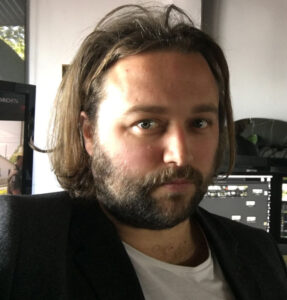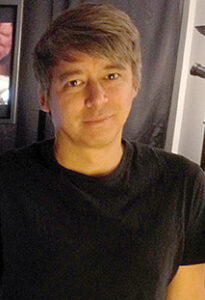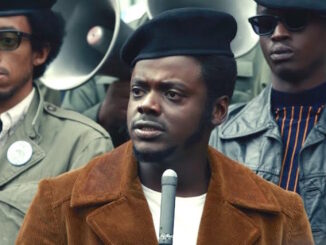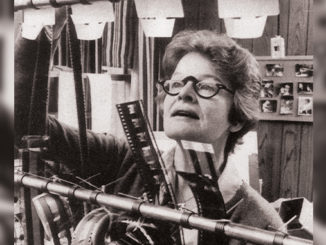
by Edward Landler
The 2017 Academy Award nominations for Best Achievement in Film Editing in 2016 offer a full array of vital work in five different movie genres: a haunting science fiction fantasy, a war story with an atypical hero, a really contemporary crime western, a Hollywood musical of Los Angeles itself, and an honest, inner-city coming-of-age drama. All five films present fresh approaches to their subject matter matched by the distinct skills of the six editing nominees.
The Oscar-nominated editors are:
Joe Walker, ACE, for Arrival, Denis Villeneuve’s film of linguist Amy Adams’ attempt to communicate with extraterrestrial beings on Earth, earning eight Academy nominations;
John Gilbert, ACE, for Mel Gibson’s Hacksaw Ridge, about a World War II medic and conscientious objector who won the Congressional Medal of Honor, which has six nominations;
Jake Roberts for David Mackenzie’s Hell or High Water, about bank robber brothers pursued by the Texas Rangers in a rural Texas hit by the recession, four Oscar nods;
Tom Cross, ACE, for La La Land, Damien Chazelle’s musical about love and artistic aspirations in the entertainment capital, with its record-tying 14 nominations; and
Nat Sanders and Joi McMillon for Barry Jenkins’ Moonlight, depicting the life of a gay African-American boy growing up in a poverty-torn community of Miami, with eight nominations.
This year’s ACE Eddie Awards have gone to Walker for Best Edited Feature Film (Dramatic) and Cross for Best Edited Feature Film (Comedy). Cross also won an Oscar in 2015 for editing Chazelle’s Whiplash, and Gilbert and Walker each have a previous nomination; Gilbert for The Lord of the Rings: The Fellowship of the Ring in 2002 and Walker for 12 Years a Slave in 2014. An Australian/US co-production, Hacksaw Ridge, won nine Australian Academy Awards including one for Best Editing for Gilbert.

Walker, Gilbert and Cross are also in contention for BAFTA’s Best Editing prize; while Roberts and Moonlight’s Sanders and McMillon, working with significantly lower budgets than their Oscar rivals, are vying for the Independent Spirit Award for Best Editing. McMillon is also the first Black editor the Academy has ever nominated for an Oscar.
Britain’s Walker first learned of Arrival while editing French-Canadian Villeneuve’s last film, Sicario (2015). The director asked him to edit the new project and he worked on it for 53 weeks, from the first day of production in early June 2015, says the editor, “to the last computer graphic image [CGI] I put in, the hardest effect of the film — Amy Adams’ hair moving in zero gravity.”
“The emotional pull of the film was really strong,” Walker recalls. “Denis made a great choice in his approach to tone with the overcast skies. Also he and [cinematographer] Bradford Young chose to consistently use a 1.9 focal length.”
The editor also accommodated for the vast amount of visual effects required. The editor says, “From the second week on, we tried to lock scenes early to get the orders out to the VFX crew as soon as possible, constantly working with temp locks so they could do their work. We put eight-frame handles on everything to have flexibility with changes. It was always a battle to get back to the main thing, to get the story together.”
The greatest difficulty in editing, though, Walker says, was “how to interweave the different time periods of Amy’s life, marbling them through the timeline of the heptapods’ presence on Earth and the events seen playing out in the world on TV screens and monitors. It was liberating that with green screen you could develop that in post.”
Another challenge came three months into post when it was decided to rethink the entire final sequence of the film with the spaceships. The editor relates, “We cobbled it all together from existing material — plates that had been shot as aerials of locations and CGI models.”
Ultimately, though, Walker says, “My intention was to keep the focus on the characters; it’s about them rather than the aliens. Editors always dance with the performances and Amy’s was an outstanding performance to work with.”
As for the aliens, he adds, “My instincts were to play some of the scenes with the heptapods quite slowly to give audiences time to feel them…and I used all the resources I’ve got to emphasize the relationship between Amy and the pods.”
New Zealand native Gilbert became editor of Hacksaw Ridge after producer Bill Mechanic recommended him to director Gibson. He cut the film at the Fox lot in Sydney near the Australian locations that stood in for the US and Pacific islands during the war.

The editor says, “About three weeks into production, my cut of about 30 seconds of the movie’s first battle scene gained Mel’s confidence. I am a collaborator but, given my head, I like to explore and try different things — and I could do that with Mel. I felt empowered by his openness.”
With the shooting on two or three cameras, an average of about three hours a day of footage came into the editing room. For the battle scenes, however, up to 10 cameras were used and Gilbert was getting six to eight hours of footage a day.
During the shoot, he says, “I was getting feedback from Mel from beginning to end and, by the second week of editing after the shoot, our assembly was already about 140 to 150 minutes. The essence of the film was there.”
Both director and editor sought to depict what Gilbert calls an “authentic reality.” He notes, “The first half was deliberately paced conventionally so that the second half clearly changed from the personal drama to the intensity of the experience of war. The emotional set up was important. I wanted the battle scenes to be particularly unrelenting, for the audience to feel that anything could happen, anyone could get shot or killed at any moment.”
Most important was making the cut work for Andrew Garfield’s performance. Gilbert points out, “Desmond Doss decided to go back into battle when he could retreat to safety with the rest of his battalion; to get the weight of that decision across is why the battle had to be as terrifying as it was.”
He also established the layout of the battles using the screen direction of the action. He adds, “Smoke also gave us a means to define the geography. Part of the cutting was to match the smoke from shot to shot to add to the continuity. We were pushing the boundaries to stress the busy-ness and the chaos. Mel brought a great deal of great footage into the room.”
Collaborating on a short and four features in the British Isles, English editor Roberts and Scottish director Mackenzie developed a strong relationship. When the director came to the US to make Hell or High Water, he insisted that Roberts join him. On their first American project, they modified a working method they developed for their last British picture, Starred Up (2013), to help maintain production momentum.
Roberts explains, “Dailies came in three or four times during the day and I’d assemble the sequences during the day and go over them with David and the director of photography in the evening. I’m entirely responsive to the dailies when they come in, like a carver paying attention to the grain of the wood.”
For the movie’s eight-week, single-camera shoot in New Mexico, the editor worked out of a cabin in Albuquerque and a Ramada Inn in Clovis. Ironically, a scheduling problem (Chris Pine’s scenes had to be shot first so he could star in 2016’s Star Trek Beyond) actually helped the filmmakers’ editing plan.

It allowed Mackenzie to shoot all of brothers Pine and Ben Foster’s scenes in sequence and then all the scenes with lawmen Jeff Bridges and Gil Birmingham hunting them down in sequence separately. The two separate halves of the story playing out simultaneously were intercut as scripted later. “Chris and Jeff appear together only in the last scene of the movie; it was shot on Chris’ last day and Jeff’s first day on set,” says Roberts.
He adds, “This helped tremendously in developing the trajectory of the characters. Things that might have been a post-production afterthought requiring reshooting were incorporated into the film during production.”
With shooting six days a week, Roberts would work up to 20 hours a day. The production had a barbeque on the day off and, says the editor, “I’d screen the rough assembly of what was shot that week for whoever wanted to come. David and I were performing a high-wire act.”
At the wrap party, the day after shooting was completed, Roberts screened a two-hour and 15-minute rough cut with the bank robber and Texas Ranger sequences interwoven. The editor notes, “It was more than just an assembly.” In post, it came down to its current one hour and 42 minutes.
Of the movies nominated for the Film Editing Oscar, La La Land was the only one actually shot on film — on 35mm anamorphic stock “to replicate Fox’s original Cinemascope aspect ratio,” says New York-transplant Cross, who cut the project for about a full year from beginning to end digitally. “My job was to put the movie together to support the emotions of the characters and the story.”
While creating naturalistic, contemporary characters, writer/director Chazelle incorporated into his planning traditional editing and optical techniques, like fades, dissolves, irises and montages. The editor says, “Damien wanted to tell the story through the language of dreams… that is, the classic Hollywood movies that inspired him and his characters. Their aspirations and dreams were based on their love of old movies.”
During a tough eight-week shoot, Cross relates, “We had little time to communicate, but Damien gave copious notes to the script supervisor which were passed on to me. He always sees how he wants to start a scene and how to finish it. I had a first rough cut completed a week after shooting wrapped; here was an abundance of riches, too many riches.”
As with Whiplash, the ending of La La Land was of crucial importance. Cross notes, “In both cases, the ending inspired the film… it was so pivotal that, after viewing the rough cut, the entire epilogue was cut first.”
As the cutting went on, the editor says that individual scenes would look great, “but putting the scenes together, we would see how some things needed to be shored up and other things weren’t necessary at all.” This became especially apparent as the pace and rhythms of the movie changed to reflect the evolving emotions and rhythms of Mia and Sebastian’s romance.

First and foremost, however, the movie is a musical and, as they had in Whiplash, director and editor labored intensively to achieve precision in where the beats would hit in relation to picture, movement and cutting. Cross says, “Throughout the editing, we worked with [composer] Justin Hurwitz’s temp score the whole way. But when we had the full score, recorded with a 95-piece orchestra, we had to examine and re-assess the synch of picture and music and we had to adjust the picture for the score.”
Moonlight editors Sanders, raised in Ohio, and McMillon, from Orlando, Florida, met almost 20 years ago as undergraduates in the College of Motion Picture Arts at Florida State University. A fellow student was writer/director Jenkins, who grew up in the film’s setting, the Liberty City neighborhood of Miami.
Sanders edited Jenkins’ first feature, Medicine for Melancholy (2008), and committed to cutting Moonlight when the filmmaker was raising production funds. When Jenkins found backing, Sanders was editor on HBO’s Girls (2012-present) with McMillon as assistant editor. He says, “I went to Barry and said I really wanted to make Joi co-editor on the project.”
McMillon continues, “Money was extremely tight. While Barry was shooting in Miami, we were editing out here — first in West Hollywood and then we moved to downtown LA — with DNX files being pushed up to us via a T-line. Basically, we cut the movie on an iMac and a laptop.”
The editors assembled the footage throughout the 25-day shoot, which wrapped Thanksgiving 2015, and had a rough assembly done early in December that ran two hours and 15 minutes. Sanders says, “Our responsibilities worked out organically. I cut the first two acts and Joi cut the third. She also cut the pivotal last scene of the first act and all the scenes with Janelle Monáe.” McMillon adds, “Nat did the last couple of scenes of Act Three.”
She also recalls that when Jenkins first watched the assembly, “He said he wouldn’t give notes, but he immediately started talking out loud and I jotted down his notes.” A month later, Sanders says, after screening the rough cut for producers, “We realized we needed to filter everything through Chiron’s perspective.”
They spent another two months in post, locking at one hour and 45 minutes. Sanders says, “A lot of the big scenes, the set-piece dialogue scenes, didn’t change from earlier cuts.” His editing partner points out, “It was mostly trying to find the overall pace and rhythm of the film.”
In retrospect, McMillon says, “Barry captured so many precise and nuanced performances. You don’t want people to pay attention to your edits, but to immerse themselves in the performances and Barry’s observations.” Sanders concludes, “It’s more of an observational film than one driven by plot. Barry was influenced by European and Asian filmmakers.”






